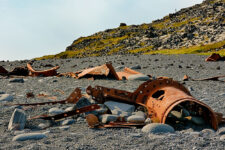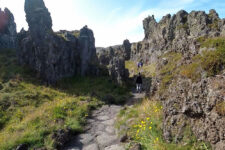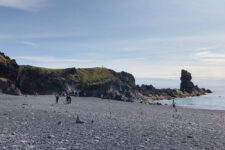Dritvík Djúpalónssandur (freely translated: deep sandy bay near Dritvik) is a bay with dark cliffs and black sand, located on the Snaefellsnes Peninsula in western Iceland. Referred to as a lava wonderland, it captivates with its harsh and dangerous beauty and hides at least two interesting stories.
The forgotten fishing village
First of all, this cove was once home to a prosperous fishing village – Dritvik. It flourished at a time when the Snaefellsnes peninsula functioned as one of the island’s most active trading places. Remnants of this period are the four stones located on the beach, between high rocks: Amlóði, Hálfdrættingur, Hálfsterkur and Fullsterkur. As the stories go, they were used for… testing the strength of fishermen. Today’s tourists usually find it difficult to pick up even the smallest of them. It’s equally hard to believe that the strongest fishermen once lifted the largest one ….
In the rocks between which we walk to the beach from the parking lot are two freshwater lagoons: Djúpulón and Svörtulón. They were once said to be bottomless, although contemporaries have measured their depth at…. about 5 meters.
The area’s natural monument is Söngklettur, or Singing Rock – a large lava rock with a reddish hue that resembles an elfin church. Nearby are other rock formations of folkloric appearance, including the alleged troll-turned-rock Kerling and Lóndrangar (note: most of the lonely rocks on the Icelandic coast are, according to legend, trolls turned into rock).
Remains of a British ship
A curiosity that attracts tourists here are the remains of a British trawler scattered on the sand
EPINA GY 9. The ship crashed east of Dritvik on the night of March 13, 1948. Although nearby rescue teams arrived to help, due to severe weather conditions, only five people out of a crew of 19 survived the disaster.
Scattered on the beach, the ship’s remains are a picturesque but nonetheless grim reminder of the disaster.
Dritvik Djupalonssandur – practical tips
When walking on Djúpalónssandur beach, use extreme caution. Iceland’s oceanic waves can be very treacherous, especially during windy, stormy weather.
Do you like the glistening pebbles that make up the beach (djúpalónsperlur – “pearls of djupalon”)? Remember that you are in a National Park (Þjóðgarðurinn Snæfellsjökull) and also the stones are protected by law and cannot be taken from the beach.
Out of respect for the sailors who died in the shipwreck, tourists are also asked to leave the remains of the ship alone.
How to get to Dritvik Djupalonssandur
To get to Dritvík Djúpalónssandur you need to get to the very end of the Snaefellsness peninsula (strictly: its east-south “corner”). From the main road of the peninsula – #54 – you turn off onto road #574, and whose sign indicates the turn to Djúpalónssandur. You can leave your car in a convenient, though often crowded, parking lot, from which a clearly marked path leads to the beach.


